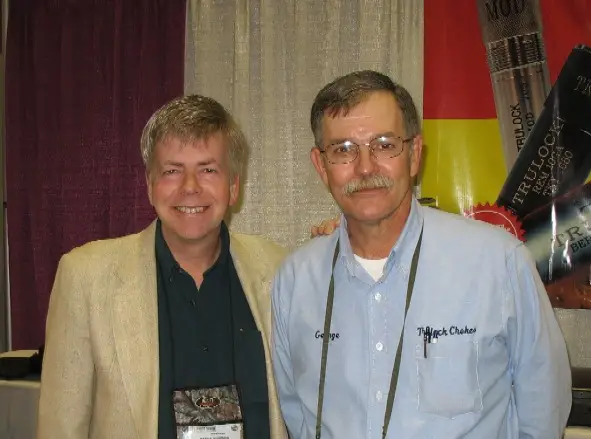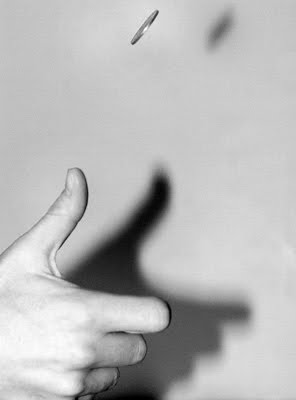


How to Pick a Choke Tube in Five Minutes or Less with George Trulock

I'm here today with the Wizard of Whigham, the King of Constriction, the Sultan of Shot, Mr. George Trulock, in the never-ending quest for finding the best choke tube. George isn't like most folks; when he's looking at “really nice threads” it isn't because he has paid a visit to a tailor. Alright, Mr. Trulock, I can certainly pick a choke in five minutes or less myself. The problem is, it won't be the best choke for my application. So let's go down the line with a few of the most common uses for shotguns and see if we can make some sense of it all. I suppose there are a few people out there that think there is the best choke from ten to seventy yards, but those folks have a better chance of paying off the federal deficit than finding that wondrous tube.
A common application would be skeet, meaning relatively light payloads of small lead shot at short ranges, not exceeding twenty-two yards or so. To me, that's a fairly easy one. A choke tube with .002 -.003 in. of constriction invariably comes very close to ideal. Is that your experience? Is there any advantage to an extended choke tube under these conditions?
George: Based on our test results we conclude that a choke with a small amount of constriction (we use .005 on skeet in 12, 16 and 20 gauge .003 on 28's) gives more consistent pattern percentages and is less likely to have holes than cylinder bore chokes. There is no significant advantage in using an extended choke with skeet loads at a short distance when you have little or no constriction.
R.W. One of the problems with a term like “constriction” that folks are fond of using, is that it doesn't mean anything unless you already have a measured, finite inside diameter of a barrel to start with. For example, I may have a choke with a .730 inch exit diameter. In the case of some of the tighter European barrels, that's no constriction at all, unless you want to call it a “negative constriction.” I'll confess to not knowing what a negative constriction is, as I've never heard of “negative blood pressure” or a boa non-constrictor. Nevertheless, if a barrel has a .723 inside diameter and the choke we screw into it has a .730 smallest inside diameter, there isn't any choking going on that I can see. What's are the ways to get a handle on what our barrel measures to start with?
George: Certainly the best way to determine bore diameter is to check it with a bore micrometer or indicating bore gauge. As bore mics are not a common measuring tool not many individuals and very few gun shops would have one unless they specialize in shotgun work. However if you want to know exactly what size bore you have this tool is the way to go. Plug gages (cylindrical gages in .001 diameter steps) will work but again these are not readily found in the home workshop and can take quite a few sizes to determine the bore diameter. Some shotgun manufacturers or importers will give you bore size info, others will not and some don't have a clue as to what bore diameter their barrels have. I believe most choke manufacturers try to determine the total spread of the bore diameter for each model of shotgun and design the choke constrictions based on a bore diameter that falls in the middle of the spread. A phone call to the choke maker of your choice should get at least the number on which they base their exit diameter's. There is no easy way to get an accurate bore diameter without having access to special measuring tools.

Above, a classic method of choke tube selection, just not a very good one.
R.W. When does it make good sense to consider an extended choke tube and when isn't it? In other words, when is an extended choke tube most likely to show an advantage, and when is it least likely to?
George: Shells with large shot charges, large diameter pellets and high velocity or any combination of these along with tight constrictions all tend to favor extended chokes. Normally we don't see as much pattern difference between flush and extended chokes when using lightly loaded shells with small diameter shot at close distances. I can also say that extended chokes work better (more even patterns) than flush chokes when using steel and or tungsten shot.
R.W. I have a confession to make. The worst factory screw-choke ever made
is the “factory modified.” It is the Chinese T-shirt of chokes,
the one that is supposed to be “medium” but often fits nothing.
Very few chokes marked “modified” are. Sadly, it is the choke
that people recommend as being “good” when it is often ungood.
It is the most poorly-used choke, likely because it is the most often
used choke. This is the wondrous factory tube that automatically becomes
a “Full” choke with steel shot of any size and velocity. Unless
you pattern, that is. George, how important is patterning your own gun
with your own shells at the ranges you want to shoot at?
George: With the exception of following safety rules, patterning your gun with your specific shell at the distance you plan to shoot is the most important thing you can do. I can make suggestions, you can listen to the advice of your friends, you can work with exotic formulas or flip a coin to determine the correct choke but if you do not actually pattern your gun you will never know for sure what it is doing from a pattern or point of aim standpoint. Last but certainly not least you will obtain a more uniform, more dense pattern with premium quality shells. A couple of suggestions are to use extended chokes when you want maximum pattern density and use extended chokes with all steel and tungsten loads. As usual there will always be exceptions to the above.
R.W.: Well, Mr. Trulock, you can always pick a choke tube in five minutes or less. Problem is, it just won't be the best one for an application, that's all. As much as we would like to avoid patterning, opting for reading breaks, our impression of what drops more birds and all of the other interesting but hopeless avenues of patterning-avoidance, there is still nothing comparable to patterning-- nor is there any substitute for it. Patterning does not mean one shot, that's as useful (or useless) as a one-shot group out of a rifle. It means at least four shots, not off-hand, but off of a steady rest. Ten patterns may be better, I believe that is what you use yourself, and no doubt twenty may be better yet. But four patterns at least gets you a representative sampling.
I know you are loathe to get into brand names of “premium shells” and so forth, but I don't have any constraints in that department. For standard lead loads, use the hardest shot you can find. For heavier hunting loads, nickel-plated or buffered loads end up being the better shells. For no-tox, Kent Tungsten-Matrix is the choice for older guns that are non-steel-rated, and often the best shells for 16 and 20 gauge due to their more generous payloads. The Federal Heavyweight loads are phenomenal, as are the Winchester HD loads. We still have to pattern, but some shells just have more potential than others.
The cheapest and the best are seldom found in the same box. We keep looking, but high-antimony shot costs more than chilled and buffered or nickel-plated loads cost more to produce than those that are not. You can't beat density of the pellet itself for less velocity erosion and deeper penetration. That means round, close to lead density or denser than shot has the edge over the fluffy stuff every time. With that, George, thanks again for your time and let's all hope that patterning determines the shell and choke, rather than the coin toss.
Copyright 2010 by Randy Wakeman. All Rights Reserved.

Custom Search



